EBA106 管理学
Section 1-2. Intro
Intro
Managers

Top Manager
- Def. Executives responsible for the overall direction of the org’
- Responsible for creating:
- Context of change
- Employee buy-in
- Positive organizational culture via language and action
Middle Manager
- Setting objectives consistent with top management’s goals 【桥梁作用】
- Planning and allocating resources to meet objectives
- Coordinating and linking divisions within a firm
- Monitoring and managing performance of subunits and managers
- Implementing strategies developed by top managers
- Responsible for facilitating team activities toward goal accomplishment
First-Line Manager
- Responsible for managing the performance of entry-level employees (who is responsible for producing a company’s goods and services)
- Responsibilities:
- Monitoring
- Teaching
- Short-term planning
- Encouraging and rewarding
Team Leaders
- Help team members:
- Plan and schedule work
- Learn problem-solving methods
- Work effectively with each other
- Foster internal and external relationships
Roles of Managers
- Interpersonal Roles
- Figurehead role: Managers perform ceremonial duties 【组织活动】
- Leader role: Managers motivate and encourage workers to accomplish organizational objectives 【对内领导】
- Liaison [联络人] role: Managers deal with people outside their units 【对外联络】
- Informational Roles
- Monitor role: Managers scan their environment for information, contact others for information, and receive unsolicited information 【信息收集与分析】
- Disseminator role: Managers share collected information with their subordinates and others in the company 【对内信息传递、收集】
- Spokesperson role: Managers share information with people outside their departments or companies 【对外信息交换】
- Decisional Roles
- Entrepreneur role: Managers adapt themselves, their subordinates, and their units to change【计划目标,上层建筑】
- Disturbance handler role: Managers respond to pressures and problems that demand immediate attention and action 【公关】
- Resource allocator role: Managers decide who gets what resources and in what amounts 【资源分配】
- Negotiator role: Managers negotiate schedules, projects, resources, goals, outcomes, and employee raises 【事务管理】
Managerial Skills
- Technical skills: 对 team leader 和底层管理者较重要
- Human skills: 与人交际,对所有管理者都重要
- Conceptual skills: 要求有整体思维,分析部分与整体的相互影响
- Motivation to manage: “管理的动力”
根据管理者等级不同,对这些技能的要求也不同。
Top 10 mistakes
- Insensitive to others: abrasive, intimidating, bullying style
- Cold, aloof, arrogant
- Betrays trust
- Overly ambitious: thinking of next job, playing politics
- Specific performance problems with the business
- Overmanaging: unable to delegate or build a team
- Unable to staff effectively
- Unable to think strategically
- Unable to adapt to boss with different style
- Overdependent on advocate or mentor
Development of Management
Scientific Management
- Goal: Use scientific approaches to improve the productivity
- See overview ⬇️

Bureaucratic and Administrative Management


Quantitative Approach of Management
- involve applying statistic, optimal models
- Use quantitative techniques to
- improve productivity
- improve quality
- reduce costly inventories
- Operations Management tools and methods:
- Productivity measurement and improvement
- Linear programming
- Work measurement techniques, etc.
Human Relations Management
- Focus on people and sees them as valuable organisational resources in their own right.
- Mary Parker Follett’s constructive conflict and coordination – Parties in a conflict should engaging in integrative conflict resolution instead of dominating the other party or compromising
- Chester Barnard – theory of cooperation in formal organisations (defined as a system of consciously coordinated activities or forces created by two or more people)
- “Hawthorne Effect”: Elton Mayo concluded that people’s behavior and attitudes are closely related, so that group factors significantly affect individual behavior.
- money is less a factor in determining output than group standards and group attitudes.
- Org’ are managed on
- how managers design jobs
- how managers work with employee teams
- how managers communicate with others
System Management & Contingency【意外事故】 Management
- System Management requires manager to think problems as a whole, including something even irrelevant.

- Contingency Management demand managers’ ability to cope with different types of problems, so there are no fixed approaches to offer.
Section 3. Environments

External Environment
Common environment factors
Global Env’
- organization’s participation in and influence from the business of other countries
- shaped by international politics and trade agreements (e.g. WTO, European Union)
Economic Env’
- Growing rate ?
- GDP ? Engel’s Coefficient ?
- How rich is the country ?
- Country’s inequality ? 【贫富差距】
- goods price ? 【物价】
- Unemployment rate ?
Demographic Env’ 【人文?】
- Birth rate ?
- Population aging ?
- Immigration ?
Different population distribution behave differently
Tech Env’
- can change the way society, organization, and individuals operate
Sociocultural Env’
- customs and values in the society which shape people’s behavior
- Traditions are passed down across generations
- influenced by economy and technology
Government & Political Env’
- the government’s regulation of business
- the relationship between business and government
Specific external environment
- Competitors【竞品】
- Customers【需求】
- Suppliers【供给】
- Industry regulation
- Advocacy/interest groups: people who try to influence business practice
- Strategic partners: work together in joint venture
How to affect managers ?
- Flexible arrangement of Jobs and Employment


- An example of POP-MART

- Labubu Phenomenon: 顺应文化潮流和情绪需求,利用市场创造现象级产品和文化(盲盒文化)
Internal Environment

Framework of Env

Organizational Culture
Def. described as the shared values, principles, traditions and ways of doing things that influence the way organization members act.
- Categories
- Innovation and Risk Taking
- Stability
- Aggressiveness: competitive rather than cooperative
- Team Orientation
- People Orientation: consider effects on people
- Outcome Orientation
- Three levels of organization culture
- Surface level: seen, observable artifacts
- Expressed level: heard, espoused【拥护】 values
- Assumption level: believed, unconscious belief
What is a strong culture?
- values shared widely
- convey consistent messages about what’s important (not contradictory)
- most employees can express
- strong connections between values and behaviors
Keys: Adaptability, Consistency, Clear Missions, Employee Involvement
Section 4. Ethics and Social Responsibility
Ethics
- Concepts
- Managerial ethics: the study of morality and standards of business conduct
- Ethical behavior follows accepted principles of right and wrong.
- Workplace deviance is unethical behavior that violates organizational norms about right and wrong.
 |
 |
- The ethical answers that managers choose depend on:
- ethical intensity of the decision
- moral development of the manager
- ethical principles to solve the problems

Ethical decision making: approaches
4 basic approaches
- The utilitarian approach 【效率】
- focuses on consequences of an action using a utilitarian approach (try to make decisions that result in “greatest good”)
- but this good may be subjective
- The moral rights approach 【规矩】
- focuses on an examination of the moral standing of actions independent of their consequences.
- choose the action that conforms with moral principles and provides positive consequences.
- The universal approach 【普适】
- choosing a course of action that you believe can apply to all people under all situations
- The justice approach 【投产比】
- focuses on the equity of process and outcomes.
- Distributive justice, Procedural justice, Compensatory justice, etc.
Steps for ethical decision making
- Selecting and Hiring Ethical Employees: overt and personality-based integrity tests
- Codes of Ethics:
- communicate its code to others both inside and outside the company
- develop practical ethical standards and procedures specific to the company’s line of business.
- Ethics Training:
- To create an ethical company culture
- To achieve credibility with employees
- To teach employees a practical model of ethical decision making
- Ethical Climate establishment:
- Top managers act ethically
- Top management actively participate in the company ethics program
- Put in place a reporting system that encourages managers and employees to report potential ethics violations i.e. whistle-blowing
Steps to encourage valid whistle-blowing:
- Clearly communicate whistle-blowing procedures to all employees. 【公开】
- Allow for reporting channels in addition to the chain of command or reporting incidents to one’s boss. 【制定规则】
- Thoroughly investigate all claims based on a consistent procedure.
- Protect whistle-blowers who make valid claims. 【鼓励】
- Provide moderate financial incentives or rewards for valid claims. 【鼓励】
- Publicly celebrate employees who make valid claims.【鼓励】
Basic Model for Ethic Decision Making
- Identify problems
- Identify constituents
- Diagnose the situation
- Analyze your option
- Make choice
- Act
Social responsibility
- Def. Social responsibility is a business’s obligation to pursue policies, make decisions, and take actions that benefit society.
- shareholder model/efficiency perspective — the only social responsibility that businesses have is to maximize profits
- stakeholder model/social responsibility perspective — management’s most important responsibility is the firm’s long-term survival

通过观察企业是否损害了 shareholders 的利益,判断企业是否对“效率”(Efficiency)负责
通过观察企业是否损害了 stakeholders 的利益,判断企业是否对“社会责任”(Social Responsibility)负责
How organizations respond
- Social responsiveness refers to a company’s strategy to respond to stakeholders’ economic, legal, ethical, or discretionary expectations concerning social responsibility
- Reactive: Company does less than society expect
- Defensive: Company admits responsibility for a problem but does the least required to meet societal expectation
- Accommodative: Company accepts responsibility for a problem and does all that society expects to solve the problem
- Proactive: Company anticipates a problem before it occurs and does more than society expects
Social responsibilities for organizations
- Economic responsibility: a company’s social responsibility to make a profit by producing a valued product or service
- Legal responsibility: a company’s social responsibility to obey society’s laws and regulations
- Ethical responsibility: a company’s social responsibility not to violate accepted principles of right and wrong when conducting its business
- Discretionary responsibility: the social roles that a company fulfills beyond its economic, legal and ethical responsibilities
Section 5. Planning
Basic Concepts
- Goal: a desired future condition that the organisation attempts to achieve
- Plan: a blueprint for goal achievement and specifies the necessary resource allocations, schedules, tasks and other actions
So what is planning?
- Planning:choosing a goal and developing methods or strategies to achieve the goal
Organisational Goals
Recap: Types of Managers

Then we extend to Levels of Goals and Plans

Then who sets the goals?
- Each manager’s responsibility for setting goals is determined by his/her level within the organization
- Goals are often negotiated between managers; it is important to set realistic goals and to ensure consensus(意见一致)

Rules of setting goals
- Be SMART: Specific, Measurable, Attainable, Realistic, Timely
- Be committed: to develop commitment by
- involving employees in particular goal-setting,
- making the goal public,
- obtaining support from top management.
- When there are multiple goals:
- Potential conflicts between goals
- To address potential conflicts, managers should understand optimisation: recognising the conflicts between goals and making balance and coordination
Organisational Planning
Planning process

Planning in different levels

See another picture to better comprehend

- Management by Objectives (MBO) was first outlined by Peter Drucker in 1954
- “Management by Objectives works if you know the objectives, 90% of the time you don’t.”
- Model of MBO Process:

- MBO benefits:
- focuses efforts on activities that lead to goal attainment
- improve performance at all company levels
- improve employee motivation
- align individual/department goals with company goals
Planning for a turbulent/uncertain environment
Contingency planning
- Rapid and uncertain environmental changes: technological, social, economic etc.
- Contingency planning respond to emergencies
- How to develop?
- identify important env factors
- forecast alternatives responses to likely cases(especially worst)
Crisis Management
涉及到一些规模较大,较紧急的事件,多数为外部环境因素。如 COVID-19,经济危机等
- Prevention & Preparation:
- detect signal from env
- designate crisis management team and spokesperson
- set up information systems
- need future-ready researches
Innovative planning strategies
Decentralized planning
- Example: Top managers or planning experts work with managers in major devisions/departments to develop their own goals and plans【扁平化管理】
Stretch goals
- Goals that are reasonable but highly ambitious and compelling【超高目标?激发潜能?】
Section 6. Decision Making
Basic Concepts
- Decision: a choice made from available alternatives
- Types of decision-making
- Programmed decisions: made for situation that has occurred often enough(predictable)
- Non-programmed decisions: made for unique situation(unpredictable) which affect consequence importantly
Programmed vs. Non-programmed Decisions
| Characteristic | Programmed | Non-programmed |
|---|---|---|
| Problem Type | Structured | Unstructured |
| Managerial Level | Lower levels | Upper levels |
| Information Availability | Readily available | Ambiguous/Incomplete |
| Solution Basis | Rules/Policies | Judgment/Creativity |
Decision-Making Models
1. Classical Model
- Assumptions:
- Clear goals, complete information, rational choice.
- Maximizes economic returns.
- Type: Normative/Prescriptive.
2. Administrative Model
- Assumptions:
- Bounded rationality, satisficing.
- Vague goals, limited information.
- Type: Descriptive.
3. Political Model
- Assumptions:
- Conflicts among coalitions.
- Bargaining under uncertainty.
- Focus: Group dynamics and negotiation.
Comparison

Decision-Making Steps
6 steps as a circle
- Recognize Requirement (Problem/Opportunity).
- Diagnose Causes (Analyze underlying factors).
- Develop Alternatives (Programmed vs. Non-programmed).
- Select Alternative (Align with goals, risk propensity).
- Implement (Managerial persuasion).
- Evaluate & Feedback (Monitor outcomes).
Individual and group decision-making
| Individual | Group |
|---|---|
| Faster | Slower (time-consuming) |
| Limited perspectives | Diverse ideas/knowledge |
| Risk of bias | Reduced bias (if managed well) |
| Accountability clear | Potential for groupthink |
Group Techniques:
- Brainstorming (no criticism).
- Nominal Group Technique (ranking ideas).
- Delphi Technique (expert consensus).
Section 7. Organizational Strategy
- Strategy is the plan of action that describes resource allocation and activities for dealing with the environment, achieving a competitive advantage, and attaining the organization’s goals.
- Resource: Plan for resource allocation to achieve competitive advantage.
- Competitive Advantage: Unique edge in meeting market needs (e.g., BYD’s battery tech).
- Sustainable Competitive Advantage: Advantage that competitors cannot replicate.
- Valuable, Rare, Imperfectly imitable or Non-substitutable resources.
To think of Effective strategy:
- What business we are in ?
- How should we compete in this industry ?
- Who are your competitors, and how should we respond to them ?
Types of Organizational Strategies
1. Corporate Strategies
| Type | Focus |
|---|---|
| Growth | Expansion via new markets/products (e.g., BYD’s vertical integration). |
| Stability | Maintain current operations. |
| Renewal | Address declining performance (retrenchment/turnaround strategies). |
Growth Subtypes:
- Concentration: Focus on core business.
- Vertical Integration: Control supply chain (e.g., BYD’s battery production).
- Diversification:
- Related: New products in related markets.
- Unrelated: New products in unrelated markets (higher risk).
2. Competitive Strategies (Porter’s)
| Strategy | Key Features |
|---|---|
| Cost Leadership | Tight cost control, efficiency (e.g., BYD’s mass EV production). |
| Differentiation | Unique product/service (e.g., Tesla’s tech innovation). |
| Focus | Target niche markets (e.g., luxury EVs). |
Strategic Tools
The BCG Matrix
- Stars: large share of a fast-growing market
- Question marks: have a small share of a fast-growing market
- Cash cows: have a large share of a slow-growing market
- Dogs: have a small share of a declining market

Porter’s Competitive Strategies (Five Forces)

Strategies
| Strategy | Characteristic |
|---|---|
| Differentiation | Acts in a flexible, loosely knit way, with strong coordination among departments Strong capability in basic research Creative flair, thinks “out of the box” Strong marketing abilities Rewards employee innovation Corporate reputation for quality or technological leadership |
| Cost Leadership | Strong central authority; tight cost controls Maintains standard operating procedures Easy-to-use manufacturing technologies Highly efficient procurement and distribution systems Close supervision; finite employee empowerment Frequent, detailed control reports |
| Focus | May use combination of above policies directed at particular strategic target Values and rewards flexibility and customer intimacy Measures cost of providing service and maintaining customer loyalty Pushes empowerment to employees with customer control |
Steps for strategy making
- Assess Need for Change
- Overcome competitive inertia (resistance to change).
- Situational Analysis (SWOT)
- Strengths: R&D capability, flexible production (BYD).
- Weaknesses: Limited high-end market presence.
- Opportunities: Government EV policies, global expansion.
- Threats: Intense competition (Tesla, Xiaomi).
- Choose Strategic Alternatives
- Use strategic reference points (risk-averse vs. risk-taking decisions).
Case Study: BYD
- Strengths: Battery tech, vertical integration, R&D investment.
- Weaknesses: Brand perception in premium markets.
- Opportunities: Global EV demand, diversification (e.g., masks).
- Threats: Price wars, trade barriers.
Section 8. Strategic Management
Strategic Management
Adaptation to the Changing Environment
- Global mindset
- Innovation
- Use of IT
Adaptive Strategies
- Defenders
- Prospectors
- Analysers
- Reactors
Case Study: BYD vs. Tesla in Electronic Vehicle(EV) Production
| BYD | Tesla |
|---|---|
| Founded in 1995 | Established in 2001 |
| In Shenzhen Stock in 2011 | In ??? in 2010 |
| “High-tech” | “Better for Transition” |
- What are their growth and competitive strategies ?
- Similarities and Differences ?
- How they adapt ?
| BYD | Tesla |
|---|---|
| higher vertical production(car, batteries, components) | depend on Chinese batteries, but investigate in China partially solve |
| lower the cost of material(batteries) obtain | |
| Most sold in China | Actively expand international market |
| Focus on Users experience |
New Trends in Strategic Management
Business Ecosystem
What’s that ?
- Case:
- Apple: iOS ecosystem, with multiple products
- Xiaomi: MIUI
- static model of business ecosystem

 ### Ecosystem Strategy
### Ecosystem Strategy
At first, think of whether we build an ecosystem or join one?
And it depends on the nature of business and specific position it occupies in the competitive landscape
- Focal【中心的】 firm’s ecosystem strategy: think of value propositions, layout of value creation
- Design governance structure of the ecosystem: defines the roles of the focal firm and the participants and govern their interactions
- (ultimate task) create ecosystem-specific competitive advantages based on ecosystem specific competencies

Section 9. Lab class
From idea to business
Consideration
- Target Market
- Problem Type
- Efficiency
- Decision Support
- Customer Engagement
- Core Offering
- Pricing Model
- Freemium vs. Paid Tiers
- Usage-Based vs. Subcription
- Delivery Channels
- Value-Add Features
MyBusiness: Games Sandbox Business
- TM
- creative users
- start-up business
- PT
- Entertainment requirement
- Idea exchanging
- CO
- Game Development Space
- Easy shared platform for players
- PM
- Free
- Price for special API / Functions (maybe)
- DC
- VR App
Section 10. Innovation
Key Concepts of Innovation
- Innovation: Implementation of creative ideas into practical solutions (e.g., Tesla’s electric vehicles).
- Creativity: Generation of unique ideas (e.g., brainstorming sessions at Apple).
- Invention: Conversion of ideas into tangible products/processes (e.g., Edison’s light bulb).
- Schumpeter’s Theory:
- Creative Destruction: New innovations replace old systems (e.g., Netflix replacing Blockbuster).
- Types of Innovation: New products, markets, processes, supply sources, or organizational structures.
Types of Organizational Innovation
| Type | Example |
|---|---|
| Product Innovation | BYD’s blade battery for EVs. |
| Process Innovation | Toyota’s lean manufacturing. |
| Organizational Innovation | Google’s 20% time policy for side projects. |
| Management Innovation | Agile methodologies in software development. |
| Service Innovation | Alibaba’s AI-powered customer service. |
Innovation Management
1. Creative Work Environment
- Components:
- Organizational Encouragement (e.g., Google’s “moonshot” projects).
- Freedom (autonomy in task execution).
- Resources (time, funding).
2. Approaches to Innovation
| Experiential Approach | Compression Approach |
|---|---|
| - For disruptive change (uncertainty). - Focus: Prototyping, testing, iteration. - Example: SpaceX’s reusable rockets. |
- For incremental change (predictability). - Focus: Speed via overlapping steps. - Example: Toyota’s Kaizen. |
Innovation Streams
- Technology Cycle: From birth to replacement (e.g., smartphones replacing feature phones).
- Stages:
- Technological Discontinuity (breakthrough innovation).
- Era of Ferment (competing designs, e.g., VHS vs. Betamax).
- Dominant Design (market standard, e.g., USB-C).
- Incremental Change (refinements, e.g., iPhone camera upgrades).
Organizational Change
Reasons for Change
- External: Market shifts, regulations (e.g., GDPR).
- Internal: Declining performance, cultural shifts.
Lewin’s 3-Step Model
- Unfreezing: Recognize need for change (e.g., Kodak acknowledging digital disruption).
- Changing: Implement interventions (e.g., adopting cloud infrastructure).
- Refreezing: Reinforce new norms (e.g., training programs).
Resistance to Change
| Cause | Mitigation Strategy |
|---|---|
| Fear of uncertainty | Education & communication. |
| Loss of control | Participation in decision-making. |
| Habitual routines | Incentivize new behaviors. |
Organizational Decline Stages
- Blinded: Ignore warning signs (e.g., Blockbuster dismissing streaming).
- Inaction: Recognize issues but delay action.
- Faulty Action: Panic-driven decisions (e.g., layoffs without strategy).
- Crisis: Severe financial/operational collapse.
- Dissolution: Bankruptcy or acquisition.
Area of Change
- Strategy
- Structure
- Technology
- People
OD (Organizational Development) Techniques
- Survey Feedback: Collect employee insights to drive change.
- Team Building: Enhance collaboration (e.g., cross-department workshops).
- Intergroup Development: Resolve conflicts between teams.
Managing Changes
Stages of changes
- Unfreezing: 知晓变化的必要性
- Change intervention: 行动
- Refreezing: 尽量确保新的改变能持久
Forces and Resistances to change
- Type of forces
- Change forces
- Resistance forces
- Reason for Resistance to Change
- Uncertainty
- Habit
- Possible loss
- Belief
- Techniques to reduce
- Education & Communication
- Participation: 让有能力不做的人参与进来
- Negotiation: 拒绝者来自较强势的群组时
- etc.
Section 11. Global Management
Global Trade Environment
Trade barriers
-
Tariffs: Taxes on imported goods (e.g., U.S. tariffs on Chinese steel).
-
Non-Tariff Barriers:
- Quotas: Import limits (e.g., EU quotas on textile imports).
- Subsidies: Government support for domestic industries (e.g., EU agricultural subsidies).
- Customs Classification: Varying import rules to restrict trade.
-
General Agreement of Tariff and Trade(GATT) -> WTO
Trade barriers & free-trade agreements
- increase choices, competition, and purchasing power
- create new business opportunities and intensify competition
Globalization
Globalization
- Definition: Integration of markets globally (e.g., Apple sourcing components from 43 countries).
- Impacts:
- Pros: Increased market access, lower consumer prices.
- Cons: Economic interdependence (e.g., 2008 financial crisis spreading globally).
Global Consistency vs. Local Adaptation
| Global Consistency | Local Adaptation |
|---|---|
| Uniform rules across countries (e.g., Starbucks’ global brand image). | Tailored strategies for local markets (e.g., McDonald’s offering rice burgers in Asia). |
Forms of globalization
- Exporting
- Cooperative contract: Foreign business owner pays a company fee for rights to conduct that business in his/her country
- Licensing
- Franchise
- Strategic alliances: Companies combine key resources, costs, risks, technology, and people
- e.g. most common: Joint venture(合资公司)
- Wholly owned affiliates【境外子公司】
- Global new ventures【境外创业公司】
Global Management Issues
1. Choose Office Locations
- Qualitative Factors:
- Workforce quality
- Company strategy
- Quantitative Factors:
- Kind of facility being built
- Tariff and non-tariff barriers
- Exchange rates
- Transportation and labor costs.
2. Minimize Political Risks
- Avoidance
- Divesting from high-risk regions (e.g., exiting markets during political instability).
- Postpone investment til risk shrinks.
- Control
- (请外国政府修改政策)
- Cooperation: Joint ventures to share risks (e.g., Toyota-GM partnership in the U.S.).
3. Cultural Differences
- Adapt companies to cultural differences
- Ensure adaptation not based on outdated assumptions.
Case Studies in Globalization
1. DJI (Dà-Jiāng Innovations)
- Global Strategy:
- Dominated consumer drones via R&D focus (e.g., Phantom series).
- Localized sales teams in the U.S., Europe, and Asia.
- Challenges:
- U.S. trade restrictions due to security concerns.
- Competition from Skydio and Autel.
2. SHEIN
- Global Expansion Tactics:
- Real-Time Data Analytics: Track trends via social media (e.g., TikTok influencers).
- Fast Fashion Supply Chain: 1-2 weeks from design to delivery vs. Zara’s 3-4 weeks.
- Risks:
- Sustainability criticisms (e.g., environmental impact of fast fashion).
- Regulatory scrutiny in the EU and U.S.
Section 13. Organisation Structure and Design
Outline
- Organisational structure
- Organisational design
- Factors affecting structural choice
Organizational Structure
Departmentalization
-
Definition: Subdividing work into separate organizational units.
-
Types:
-
Functional: Based on business functions (e.g., Sales, Finance).
- Pros: Efficiency, internal coordination, specialization.
- Cons: Poor cross-department communication, limited goal alignment.
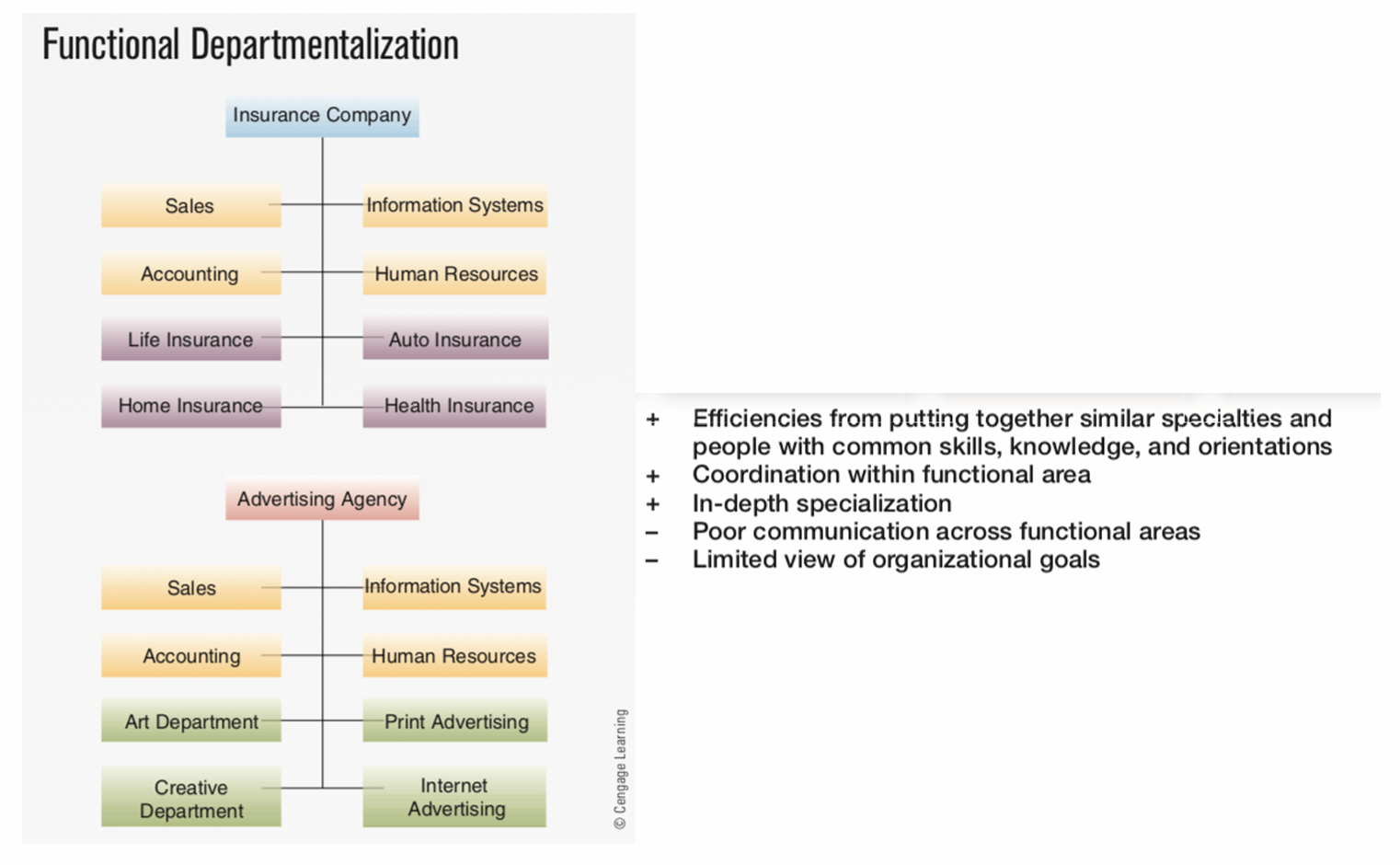
-
Product: Organized by specific products/services (e.g., BYD Electronics).
- Pros: Product expertise (利好专业管理者), closer to customers (需求向).
- Cons: Duplication of functions, fragmented goals.
-
Geographic: Divided by regions (e.g., Huawei’s global operations).
- Pros: effective handling local issues, better serve needs of unique geographic markets
- Cons: Redundancy, isolation from other units.
-
Customer: Focused on customer segments (e.g., Retail, Wholesale).
- Pros: solutions for unique needs.
- Cons: Functional duplication.
-
Matrix: Hybrid structure (e.g., Procter & Gamble).
- Pros: Resource pooling, efficient complex task management.
- Cons: High coordination complexity.

-
Organizational Authority
Def. 为达成组织目标的可行使权力
-
Types of Authority:
- Line Authority: Direct command over subordinates (e.g., production managers).
- Staff Authority: Advisory role for non-subordinates (e.g., HR consultants).
-
Span of Control:
-
Definition: Number of employees a manager can effectively

- **Narrow Span **: More layers, suited for complex tasks.
- Wide Span : Fewer layers, suited for standardized tasks.
-
-
Delegation of authority
- Centralization vs. Decentralization:
- Centralization: Stable environments, minor decisions, crisis scenarios.
- Decentralization: Complex environments, significant decisions, dispersed operations.
- Centralization vs. Decentralization:
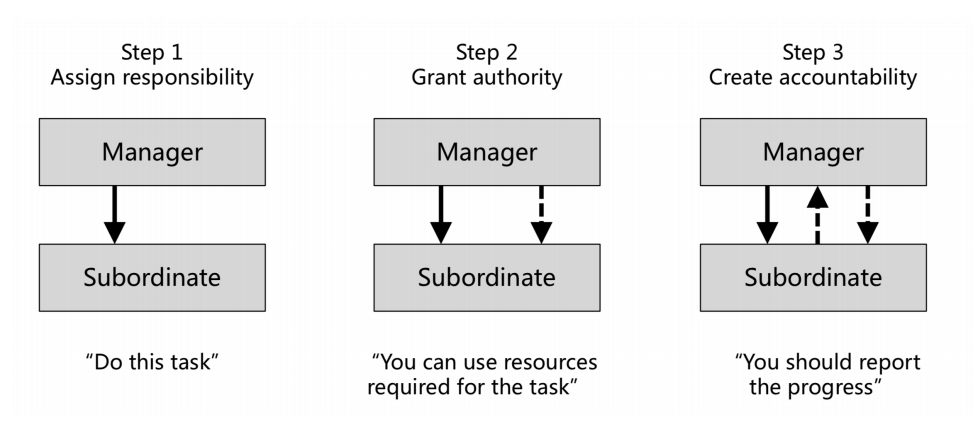
Organizational Design
Job Design
- Definition: Structuring tasks within roles for efficiency and engagement.
- Methods:
- Job Rotation: Shifting employees across roles periodically.
- Job Enlargement: Expanding task variety within a role.
- Job Enrichment: Adding decision-making authority to tasks.
Organizational Design Process
Organizational Process: Collection of activities that transform inputs into outputs that are valued by customers
-
6 key elements: job/work specialisation, departmentalisation, chain of command, span of control, centralisation/decentralisation, formalisation [工作是否遵循一定规章制度/标准]
-
Mechanistic vs. Organic Structures:
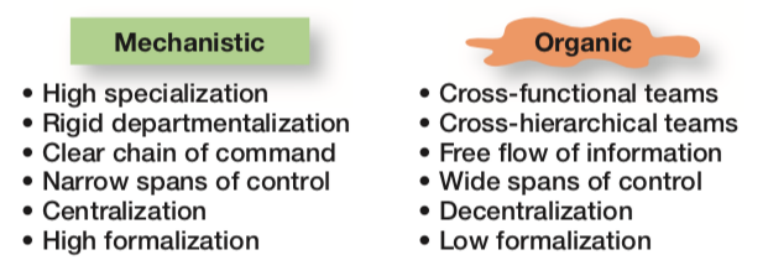
Intraorganizational Processes
-
通过内部活动完成输入到输出
-
Reengineering: Redesigning workflows by altering task interdependence.
- Types of Interdependence(工作流程):
- Pooled: Independent contributions.
- Sequential: Linear workflow dependencies.
- Reciprocal: Collaborative back-and-forth processes.
- Types of Interdependence(工作流程):
-
Empowerment: Delegating decision-making authority to employees. [下放权力]
Interorganizational Processes
-
通过企业之间的活动完成输入到输出
-
Modular Organizations: Outsourcing non-core activities (e.g., design, logistics).
- Pros: Cost efficiency; Cons: Loss of control.
-
Virtual Organizations: Network-based collaboration (e.g., shared resources).
- Pros: Flexibility, speed; workers combine efforts; allow cost sharing
- Cons: Quality control challenges.
Factors Affecting Structural Choice
什么因素会影响“机械化/有机组织结构”的选择?
- Strategy
- Innovation: Requires organic structures (flexibility, open communication).
- Cost Control: Suits mechanistic structures (standardization, stability).
- Size
- Large Organizations (>2,000 employees): Tend toward mechanistic structures (formalization, centralization).
- Technology
- Routine Technology: Aligns with mechanistic structures.
- Non-Routine Technology: Favors organic structures.
- Environmental Uncertainty
- Stable Environments: Mechanistic structures perform better.
- Uncertain Environments: Require organic flexibility.
Section 14. Managing work teams
Outline
- Work teams: basic concepts
- Pros and cons of using teams
- Different types of teams
- Characteristics of teams
- Methods used to enhance work team effectiveness
Basic Concepts of Work Teams
Definition of Work Teams
- Work Teams: Small groups with complementary skills who are mutually accountable for:
- Pursuing a common purpose
- Achieving performance goals
- Improving interdependent work processes
Groups vs. Teams
| Aspect | Group | Team |
|---|---|---|
| Leadership | Designated leader | Shared/rotated leadership |
| Accountability | Individual [对一人负责?] | Individual + Mutual [相互负责?] |
| Purpose | Aligns with organizational goals | Specific team vision |
| Work Products | Individual outputs | Collective outputs |
| Effectiveness Measurement | by influence on business | by assessing collective work |
| Decision-Making | Delegates tasks to individuals | Collaborative problem-solving |

Pros and Cons of Using Teams
Advantages
- Improved Performance: Faster product development, higher quality, and efficiency.
- Enhanced Job Satisfaction: Skill development through cross-training.
- Share the benefits of group decision making (see Sec.6)
Disadvantages
- Social Loafing: Members withhold effort.
- Conflict: Cognitive (task-related) vs. Affective (emotional).
- Groupthink [从众效应]
- Minority domination [被个人主导讨论方向]
When to Use Teams
- ✅ Clear purpose requiring collaboration.
- ✅ Resources and rewards for teamwork.
- ❌ Tasks can be done independently.
- ❌ Lack of alignment or resources.
Types of Teams
Based on Autonomy
| Type | Workers/Employees | Managers |
|---|---|---|
| 1️⃣ Traditional Groups | Execution No direct control |
receive reports from workers responsible for workers’ performance authority to hire and fire them |
| 2️⃣Employee involvement teams | Provide advice or make suggestions do not have the authority to make decisions Membership: voluntary but expertise |
make decisions (Basic Logic: people closest to the problem or situation are best able to recommend solutions.) |
| 3️⃣Semi-autonomous Groups | have the (limited) authority to make decisions solve problems related to the major tasks typically cross-trained in diversified skills and tasks |
still play a role but less dominant |
| 4️⃣Self-Managing Teams | manage and control crucial tasks(high authority) | - |
| 5️⃣Self-Designing Teams | Share characteristics of self-managing teams control team design, work tasks, and team membership(full auth) |
(all decided by members) |
Specialized Teams
- Cross-Functional: Members from different departments (e.g., marketing + engineering).
- Project teams: [一次性项目]
- Virtual: Geographically dispersed members using digital tools.
- Global: Culturally diverse teams requiring sensitivity to norms and communication styles.
- Managing global teams (see Sec.10)

Team Characteristics
Key Factors
-
Norms: Informal rules guiding behavior (e.g., punctuality, honesty).
-
Cohesiveness: Attraction to the team, which enhanced by:
- Present of members in team activities
- opportunities for task interdependence
- Engaging in non-work activities
-
Size: Optimal size = 6–9 members (balances diversity and coordination).
- too large: social loaf; minority domination
- too small: lack diversity of skills; no benefit from team decision making
-
Conflict: Manage cognitive conflict (task-focused) and minimize affective conflict.
Stages of Team Development
- Forming: Members get acquainted.
- Storming: Conflict over goals/methods.
- Norming: Roles and norms solidify.
- Performing: Peak efficiency.
- Adjourning: Wrap-up for temporary teams.
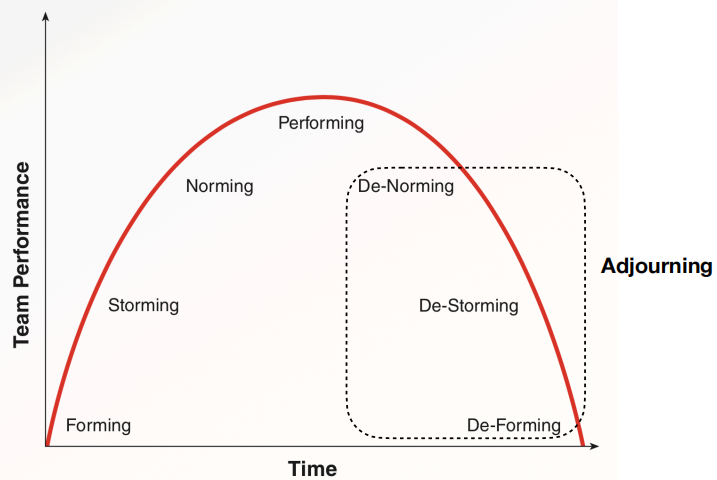
Enhancing Team Effectiveness
Setting goals & priorities
- SMART Goals: Specific, measurable, and challenging.
- Stretch Goals: Ambitious, seems unreachable.
- Effective for teams that: 1️⃣ have high autonomy to achieve goals; 2️⃣ empowered with control of resources; 3️⃣ have structural accommodation and bureaucratic immunity
- Structural accommodation: authorize teams to change org structures/policies/practices
- Bureaucratic immunity: ability to make changes without getting approval from managers/…
- Effective for teams that: 1️⃣ have high autonomy to achieve goals; 2️⃣ empowered with control of resources; 3️⃣ have structural accommodation and bureaucratic immunity
Selecting members
-
Individualism-collectivism [集体主义 vs 个人主义]
-
Diversity: Balance skills, personalities, and cultural backgrounds.
-
Team Player Inventory: Assess preference for teamwork vs. individual work (need higher)
Training & Rewards
- Training Areas(Interpersonal): Conflict resolution, decision-making, technical skills.
- Compensation: Skill-based pay, gainsharing [员工带来的收益需要益及员工], non-financial recognition.
Section 15. Human Resource Management
HRM Overview
Definition: Process of attracting, developing, and retaining a qualified workforce. [“找合适的牛马”]
Key Functions:
- Recruitment & Selection: 公司需要能吸引求职者的技巧
- Training & Performance Appraisal: 需要培养应聘者的专业技术
- Compensation & Employee Separation: 筛选——留下的给予报酬,离开的做好“手续”?
Strategic Alignment: HRM integrates company strategy with workforce management.

External factors
- Economy
- Laws and regulations
- Labour unions [工会?]
- Demography [人口状况]
Recruitment & Selection
Recruitment Methods
| Internal Recruitment | External Recruitment | |
|---|---|---|
| Def | Promotion from within | a pool of qualified job applicants from outside the company |
| Methods | Job posting & Career path(planned sequence of jobs) | Career Portals(advertise/job site), employee referrals, Special events, Social media |
Case Study: Huawei’s Dual-Career Path

Selection Process
- Application Review: Résumés and forms.
- Background Checks: Verify credentials.
- Interviews:
- Structured: Standardized questions (e.g., behavioral interviews).
- Unstructured: Flexible questioning.
- Tests:
- Specific ability or aptitude tests: ability needed for the job
- Cognitive ability tests: employee’s perceptual speed, verbal comprehension
- Biographical data: personal backgrounds and life experiences
- Personality assessments: job-related personality dimensions
- Work simulations
Training & Performance Appraisal
Training Methods
| Objective | Methods |
|---|---|
| Knowledge/Info Transfer | Lectures, e-learning modules |
| Skill Development | Case studies, group discussions |
| Behavioral Change | On-the-job training, role-playing, simulations |
- ⚠️: All these can be developed by e-learning (computer-based).
Huawei Example:
- Training aligned with business needs.
- Internal experts as trainers.
Performance Appraisal
Common Errors:
- Central Tendency: Rating all employees as in middlee scales.
- Halo error: “All employees perform the same in all parts”
- Leniency Bias: “All perform well”
Improvement Strategies:
- Use Behavioral Observation Scales (BOS) for specific criteria.
- Train evaluators to avoid biases.
Huawei’s System:
- Biannual evaluations (Grades A+ to D).
- Grades impact salary, bonuses, and stock options.
Compensation & Separation
Types of Compensation Decisions
- Pay-level: whether to pay a worker in a level that is below, above or at current market wages.
- Pay-variability: extent to which employee’s pay varies with individual and organization performances.
| Option | Description |
|---|---|
| Piecework | Employees are paid a set rate for each item they produce |
| Commissions | Employees earn a percentage of each sale they make |
| Profit sharing | Company pays a percentage of its profits to employees in addition to regular compensation |
| Employee stock ownership plans (ESOPs) | Employees are awarded shares of company stock in addition to regular compensation |
| Stock options | Employees have the right to purchase shares of stock at a set price |
- Pay-structure: extent to which people in the company receive very different levels of pay
| Pay Structure | Description |
|---|---|
| Hierarchical | Large pay gaps between levels. |
| Compressed | Smaller pay differences. |
Huawei Case:
- Salary + performance bonus + stock dividends.
- Promotions based on biannual evaluations.
Employee Separation
Best Practices for Layoffs:
- Provide clear explanations.
- Offer outplacement services (e.g., counseling).
- Concern of non-seaprated employees (e.g. why they are not terminated)
Retirement Plans:
- Early Retirement Incentives (ERIPs).
- Phased Retirement: Gradual reduction in work hours.
Employee turnover
- Functional turnover: Loss of poor-performing employees
- Dysfunctional turnover: Loss of high-performing employees
Section 16. Managing Diversity
The Importance of Diversity for Organizations
Definition of Workplace Diversity
- Variety of demographic, cultural, and personal differences among employees and customers.
- Value: Differences enhance innovation and drive business success.
Diversity vs. Affirmative Action
| Diversity | Affirmative Action |
|---|---|
| Broad focus (demographic, cultural, personal) | Targets minorities/women |
| Exists naturally | Requires purposeful steps |
| Goal: Inclusive environment | Goal: Legal compliance |
Business Benefits
- Cost Savings: Reduces turnover and lawsuits.
- Talent Attraction: Appeals to a broader talent pool.
- Problem-Solving: Diverse teams yield higher-quality solutions.
- Market Growth: Better understanding of diverse customer bases.
Types of Diversity
- Surface-level [直接发现]
- Deep-level [需要进一步了解才能发现]
- Hidden-level [暂未发现]
Challenges Brought by Diversity
Personal Bias
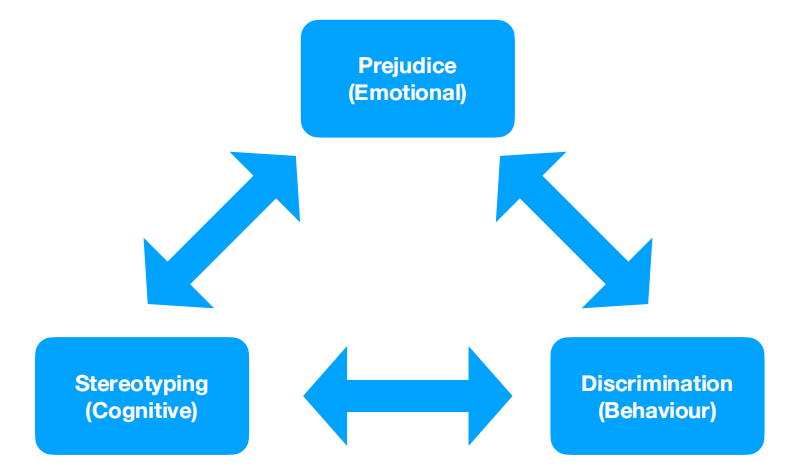
Surface-Level Diversity Challenges
| Discrimination Type | Example | Mitigation Strategies |
|---|---|---|
| Age | Overlooking older employees for training | Monitor training access, foster intergenerational collaboration. |
| Gender | “Glass ceiling” limiting women’s advancement | Mentorship programs, inclusive social activities. |
| Race/Ethnicity | Hiring disparities | Standardize selection criteria, conduct audits. |
| Disabilities | Lack of accommodations | Provide assistive tech, actively recruit. |
Case Study: “Bamboo Ceiling”
- Issue: Asian-Americans face career barriers due to stereotypes.
- Solution: Challenge stereotypes, promote inclusive leadership.
Impacts on Individual Behavior and Workplace Interactions
Deep-Level Diversity
- Big Five Personality Dimensions:
- Extraversion: Sociability vs. introversion. (外向/内向表达方式)
- Emotional Stability: Resilience vs. anxiety. (情绪稳定性)
- Agreeableness: Cooperativeness. (“靠谱”)
- Conscientiousness: Organization and reliability. (努力,效率)
- Openness to Experience: Creativity and adaptability. (创造性)
Shifting from Surface to Deep-Level Diversity
- Process: Move beyond stereotypes to understand individual behaviors.
- Outcome: Reduces conflict, improves teamwork.
Managing Diversity
Diversity Paradigms
| Paradigm | Focus | Pros/Cons |
|---|---|---|
| Discrimination & Fairness | Compliance with laws | Ensures fairness but limits diversity to surface traits. |
| Access & Legitimacy | Aligns workforce with stakeholders | Boosts representation but may tokenize. |
| Learning & Effectiveness | Integrates deep-level differences | Fosters innovation, minimizes conflict. |
Strategies for Organizational Plurality
Def. Organisational plurality is a work environment where
- members are empowered to contribute, maximising for both sides
- individuality of each member form equity (like no bias)
Principles:
- Follow and enforce laws
- Treating groups differently but not special
- Find common grounds
- Tailoring opportunities to individuals, not groups
- High standards & realistic goals
- Solicit feedback (both sides)
Methodology:
- Training Programs:
- Skills-Based: Conflict resolution, negotiation.
- Awareness Training: Challenges stereotypes.
- Diversity Audits: Assess policies and promote fairness.
- Diversity Pairing: Cross-cultural mentorship.
Key Principles
- Tailor opportunities to individuals, not groups.
- Maintain high standards while respecting differences.
- Set realistic goals for inclusivity.
Section 17. Managing Communication
Perception in Communication
Definition
- Process of attending to, organising, interpreting, and retaining environmental information.
- Influenced by perceptual filters (personality/experience-based biases).
Perception Process Diagram
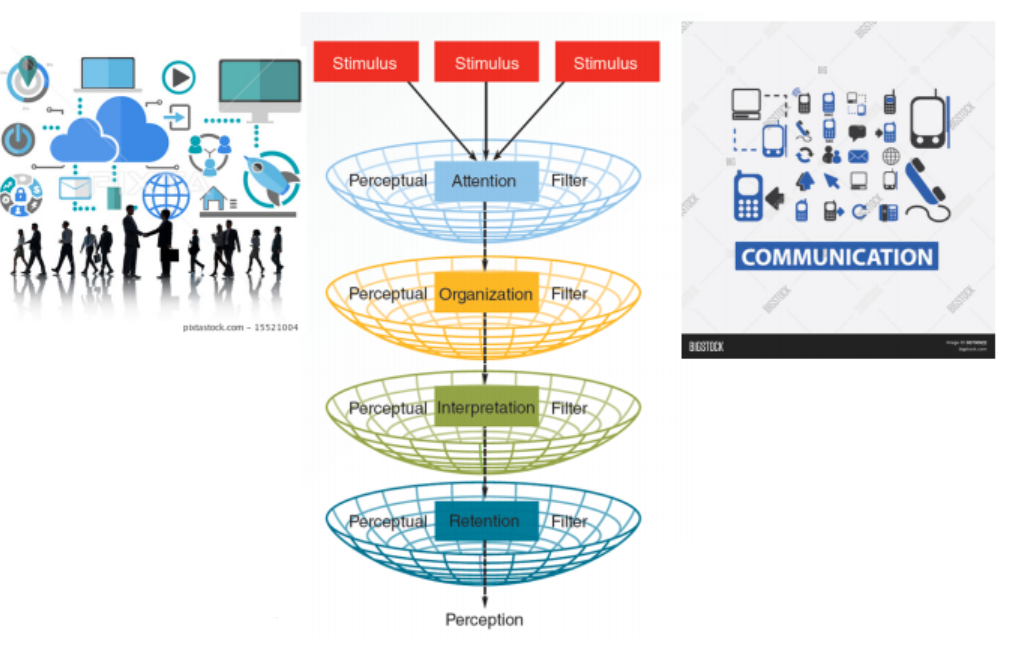
Perception Problems
| Problem | Description |
|---|---|
| Selective Perception | Noticing information consistent with one’s beliefs; ignoring inconsistencies |
| Closure | Filling information gaps assuming new data aligns with existing knowledge |
Attribution Theory
| Concept | Description |
|---|---|
| Internal Attribution | Attributing behavior to personal control/voluntary [个人原因] |
| External Attribution | Attributing behavior to situational factors/involuntary [环境,外部原因] |
Possible mistakes in attribution
| Concept | Description |
|---|---|
| Defensive Bias | perceive as having similar troubles as others (external attribution) |
| Fundamental Attribution Error | ignoring external factors |
| Self-Serving Bias | Attributing personal success to oneself; blaming failures on external factors [双标] |
Communication Process
Key Components
- Sender: Initiates message
- Encoding: Translating ideas into symbols/language
- Message: Content transmitted
- Medium: Channel used (e.g., email, face-to-face)
- Receiver: Interprets the message
- Decoding: Attaching meaning to the message
- Feedback: Receiver’s response to the sender (3 types)
- Noise: Interference in transmission (e.g., jargon, unclear encoding)
- Context: Environment affecting communication
Basic Communication Model Diagram

Types of Feedback
| Type | Description |
|---|---|
| Informational | Non-evaluative information from receiver |
| Corrective | Challenges the original message |
| Reinforcing | Confirms clear receipt and understanding |
Organizational Communication Channels
Formal Channels
| Direction | Description |
|---|---|
| Downward | Higher → Lower levels (e.g., policies) |
| Upward | Lower → Higher levels (e.g., feedback) |
| Horizontal | Same-level communication (e.g., coordination) |
Informal Channels
-
Grapevine: Employee-driven, rapid information flow. [小道消息]
- Advantages: Timely, reduces misunderstandings.
- Disadvantages: Risk of misinformation.
-
Types
- Gossip chain – [中心发散]
- Cluster chain – [树状发散]
Other Types
| Type | Description |
|---|---|
| Coaching (one-to-one) | Improving job performance (often reactive; delayed) |
| Counselling (one-to-one) | Addressing non-job issues affecting performance |
| Nonverbal Communication | Body language (kinesics), tone (paralanguage) supporting/contradicting verbal messages |
Managing Effective Communication
One-on-One Communication
-
Choose the Right Medium:
- Oral: Immediate feedback, assesses nonverbal cues.
- Written: Best for straightforward messages.
-
Active Listening:
- Techniques: Immediacy behaviors (eye contact), paraphrasing, summarizing.
- Empathetic Listening: Understand speaker’s perspective; reflect feelings (e.g., “You seem frustrated…”).

- Feedback:
Type Description Destructive Disapproving; triggers defensiveness Constructive Helpful, specific, problem-oriented
Organizational Communication Networks
| Network | Speed | Accuracy | Leader Emergence | Member Satisfaction |
|---|---|---|---|---|
| Chain | Moderate | High | Moderate | Moderate |
| Wheel | Fast | High | High | Low |
| All Channel | Fast | Moderate | None | High |

Improving Organizational Communication
| Goal | Methods |
|---|---|
| Transmission | Email, discussion forums, broadcast voice mail, videotaped meetings |
| Reception | Company hotlines, surveys, informal meetings, blogs (to counter organizational silence) |
- Some challenges brought by new techs [针对 transmission]
- Legal and security issues
- Lack of personal interaction
Section 18. Managing Motivation
Motivation Fundamentals
Definition
- Set of forces that initiates, directs, and sustains effort toward goal achievement.
- 3 Elements:
- Initiation of effort
- Direction of effort
- Persistence of effort
Motivation-Performance Relationship
| Factor | Description |
|---|---|
| Job Performance | Determined by motivation, employee ability, and situational constraints |
| Effort → Performance | Effort (initiation/direction/persistence) directly impacts performance |
Motivation Model Diagram

Needs and Rewards
Maslow’s Hierarchy of Needs
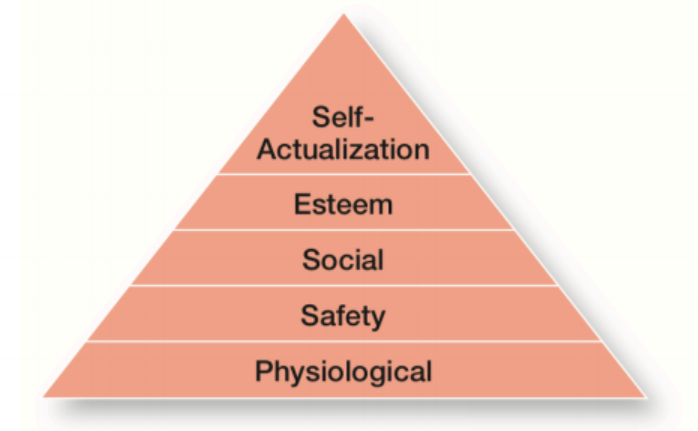
Reward Types
| Type | Description | Example |
|---|---|---|
| Extrinsic | Tangible rewards contingent on performance | Salary, bonuses, promotions |
| Intrinsic | Natural rewards from task performance | Sense of achievement, growth |
Steps to Motivate
- Enquire about employees’ needs
- Satisfy lower-order needs first (safety/physiological)
- Expect needs to evolve over time
- Create opportunities for higher-order needs (intrinsic rewards)
Motivation Theories
1. Equity Theory
- Motivation arises when people perceive fair treatment in:
- Inputs (contributions) vs. Outcomes (rewards)
- Compared to referents (others)
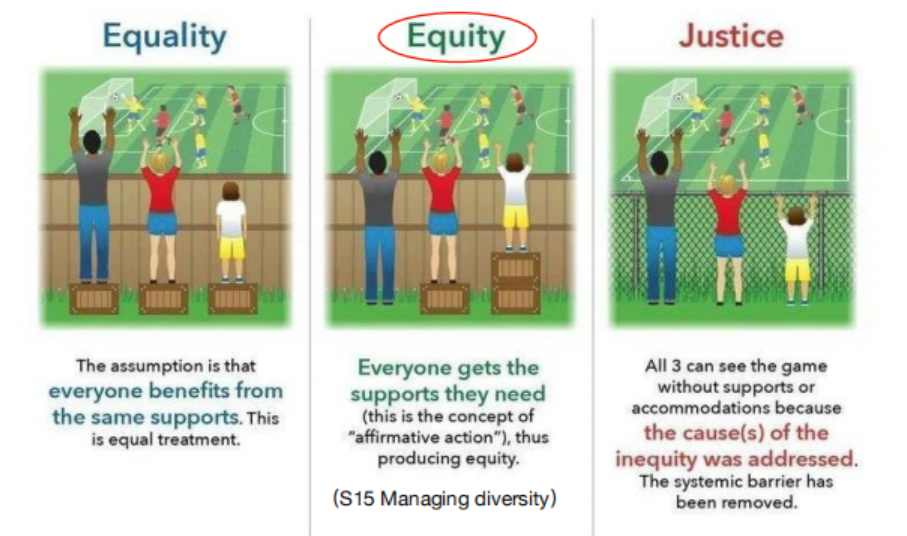
Forms of Inequity
| Type | Description | Employee Reaction |
|---|---|---|
| Underreward | Worse O/I ratio than referent | ↓ Inputs, ↑ Outcomes, rationalize, leave |
| Overreward | Better O/I ratio than referent | Guilt-driven productivity increase |
Motivating Strategies
- Ensure distributive justice (fair reward distribution)
- Ensure procedural justice (fair decision-making processes)
- Reduce employees’ inputs when appropriate
2. Expectancy Theory
- Motivation depends on belief in:
- Expectancy: Effort → Performance linkage
- Instrumentality: Performance → Reward linkage
- Valence: Reward attractiveness
Motivating Strategies
- Identify employees’ desired rewards
- Link rewards clearly to performance [目的:提高期望]
- Empower employees to make decision
3. Reinforcement Theory
- Behavior frequency changes based on consequences:
- ↑ with positive consequences
- ↓ with negative consequences
Reinforcement Contingencies [强化相倚]
| Type | Effect on Behavior | Example |
|---|---|---|
| Positive Reinforcement | Strengthens | 发奖学金 |
| Negative Reinforcement | Strengthens | 将功赎罪 |
| Punishment [oppose to NR] | Weakens | 旷课一日留堂一周 |
| Extinction [oppose to PR] | Weakens | 品行问题取消奖学金 |
Reinforcement Schedules
| Schedule | Description | Example |
|---|---|---|
| Continuous | Reward after every behavior | Commission per sale |
| Intermittent | Reward at intervals/after behavior averages | Quarterly bonuses |
Intermittent Subtypes
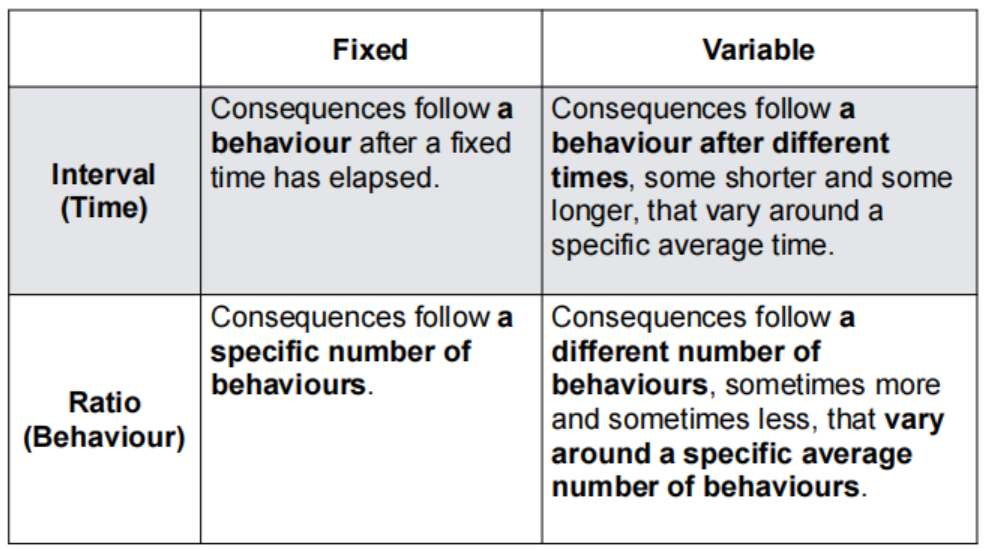
Motivating Strategies
- Steps: Identify, measure, analyse, intervene, and evaluate
4. Goal-Setting Theory (Recap Sec 5. Organizational Goals)
- Motivation requires:
- Specific, challenging goals
- Feedback on progress
Motivating Strategies
- Ensure goal acceptance
- Provide frequent, specific feedback
Managerial Actions Summary
| Theory | Key Actions |
|---|---|
| Basics | Address evolving needs; prioritize intrinsic rewards for higher-order needs |
| Equity Theory | Correct inequities; ensure fair procedures |
| Expectancy Theory | Clarify effort→performance→reward links; empower employees |
| Reinforcement | Use contingencies strategically; avoid punishing desired behaviors |
| Goal-Setting | Set specific/challenging goals; align with organizational objectives |
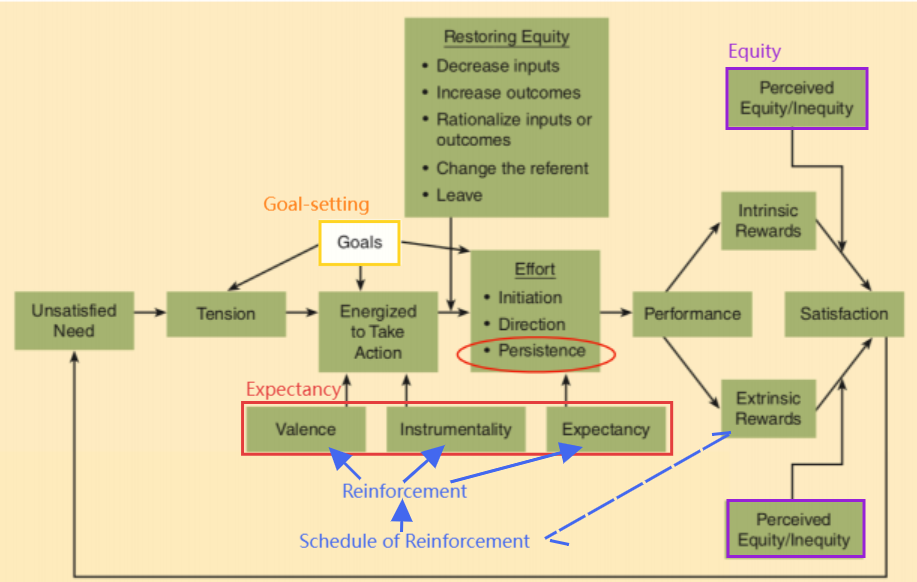
Section 19. Leadership
Leaders vs. Managers
| Aspect | Leaders | Managers |
|---|---|---|
| Focus | Vision, mission, goals | Productivity, efficiency |
| Risk Approach | Encourage creativity and risk-taking | Preserve status quo |
| Time Perspective | Long-term | Short-term |
| Concern | Ends (outcomes) | Means (processes) |
Leadership Definition
- Leader: Influences others and holds managerial authority
- Leadership: Process of influencing a group to achieve goals
- Ideal: All managers should be leaders (leading is one of the four management functions)
Leadership Theories
1. Trait Theory
Traits: Relatively stable characteristics
Effective leaders share these traits:
- Drive, desire to lead, honesty/integrity
- Self-confidence, emotional stability
- Strong cognitive ability, business knowledge
2. Behavioral Theories
Initiating structure: Degree to which a leader structures the roles of his or her followers by:
- Setting goals
- Giving directions
- Setting deadlines
- Assigning tasks
Consideration: Extent to which a leader is friendly, approachable, and supportive and shows concern for employees
Key Research Findings
| Study | Behavioral Dimensions | Conclusion |
|---|---|---|
| Univ. of Iowa | - Democratic - Autocratic - Laissez-faire |
Democratic style most effective (mixed later results) |
| Ohio State | - Consideration (employee-focused) - Initiating structure (task-focused) |
“High-high” leaders achieve high performance/satisfaction (situational) |
| Univ. of Michigan | - Employee-oriented - Production-oriented |
Employee-oriented leaders linked to higher productivity/satisfaction |
| Managerial Grid | - Concern for people (1-9) - Concern for production (1-9) |
Best performance with 9,9 style (high both dimensions) |
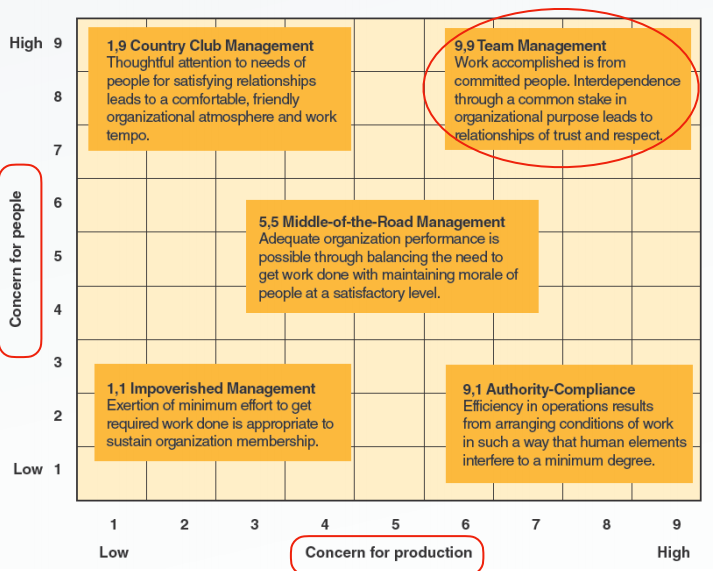
Contingency Theories
1. Fiedler’s Contingency Model
- LPC Questionnaire measures leadership style:
- $\gt 64$: Relationship-oriented
- $\le 57$: Task-oriented
- $58-63$: Flexible
- Situational Favourableness depends on:
- Leader-member relations
- Task structure
- Position power
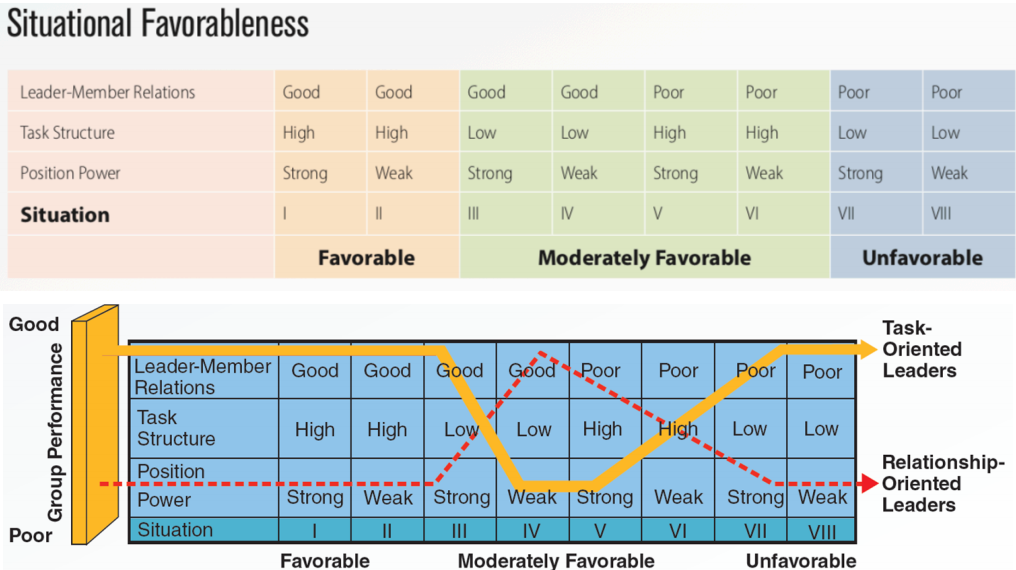
2. Hersey & Blanchard’s Situational Theory
Match leadership style to follower readiness:
| Readiness Level | Description | Leadership Style |
|---|---|---|
| R1 | Unable/unwilling to take responsibility | Telling (directive) |
| R2 | Willing but unable | Selling (coaching) |
| R3 | Able but unwilling | Participating (supportive) |
| R4 | Able and willing | Delegating |
3. Path-Goal Theory
Recap: Expectancy Theory
Increase satisfaction/performance by:
- Clarifying paths to goals
- Increasing rewards for goal attainment
Leadership Behaviors
| Behavior | Use When… |
|---|---|
| Directive [指导型] | Unstructured tasks; inexperienced workers |
| Supportive [支持、友好型] | Repetitive tasks; stressful environments |
| Participative [成员参与型] | Complex tasks; internal-locus employees |
| Achievement-Oriented [激励型] | Unchallenging tasks; high-ability workers |
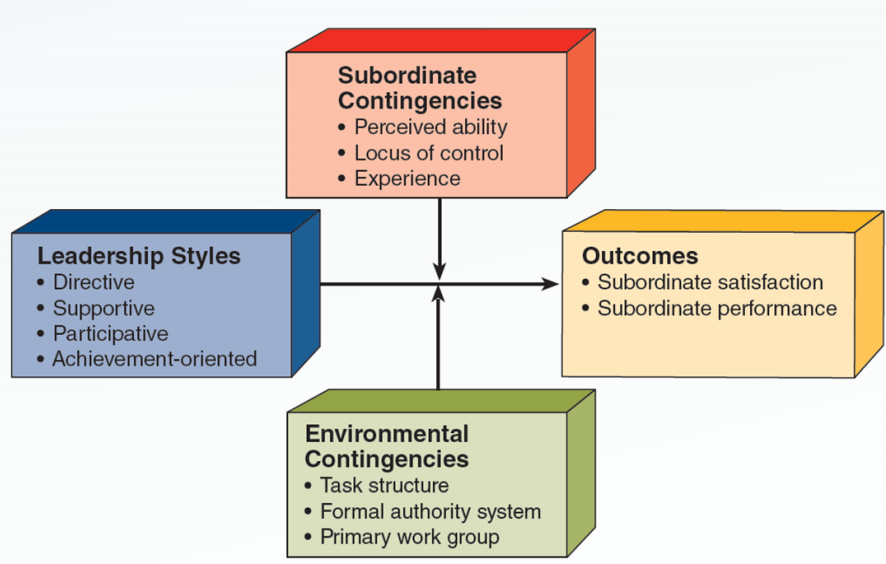
4. Normative Decision Theory
Decision Styles
- Autocratic $\leftrightarrow$ Consultative $\leftrightarrow$ Group decision
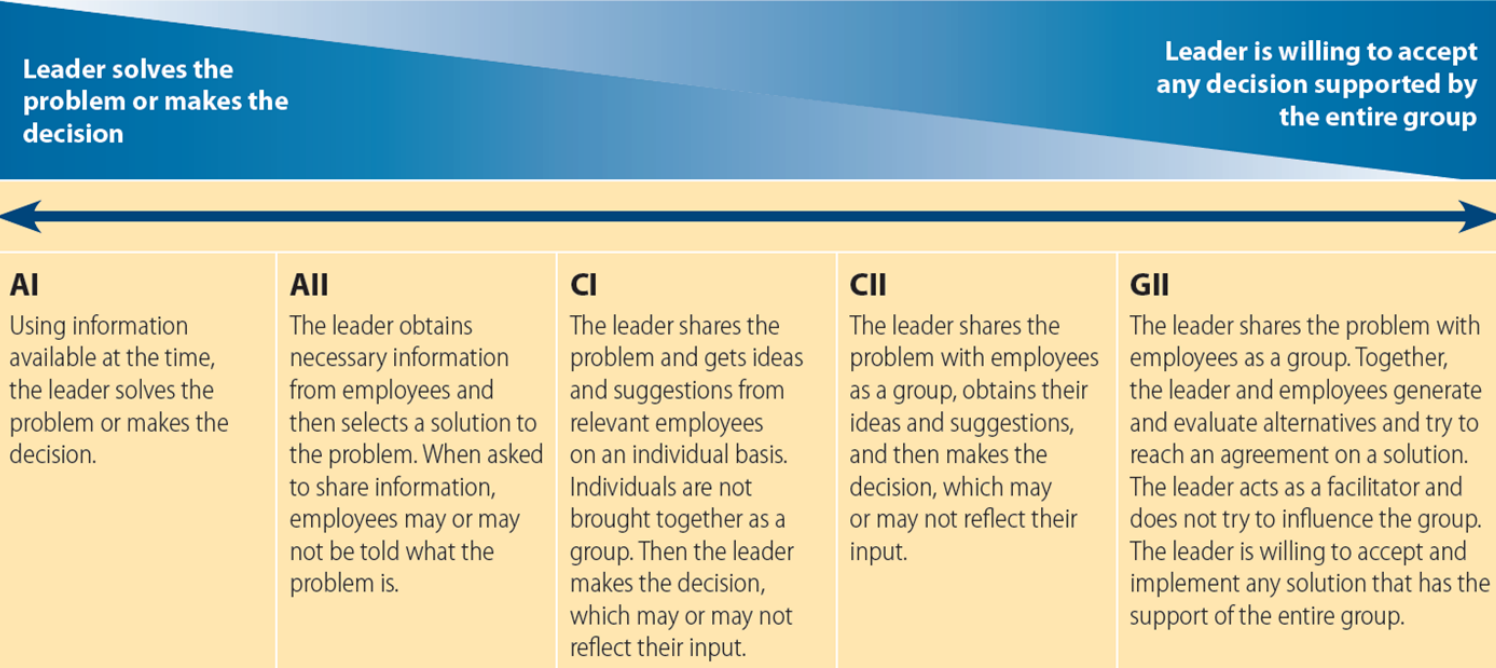
Key Decision Rules
-
For Quality:
- Avoid autocratic style(A) if leader lacks info or problem is unstructed.
- Avoid G-style if subordinate’s goals different from org goal
- Avoid G-style if subordinate lacks info
-
For Acceptance: Use group style(GII) when:
- Subordinate acceptance is critical
- Conflict is likely (about implementation)
- Goals align with organization
Visionary Leadership
Charismatic Leadership
| Type | Characteristics |
|---|---|
| Ethical Charismatics | - Develop followers - Open to pos/neg feedback - Prioritize organizational/societal interests |
| Unethical Charismatics | - Manipulate followers - Self-serving - Prioritize own interests |
Transformational vs. Transactional
| Aspect | Transformational Leadership | Transactional Leadership |
|---|---|---|
| Focus | Inspire beyond self-interests | Exchange process (rewards/punishments) |
| Components | 1. Idealized influence 2. Inspirational motivation 3. Intellectual stimulation 4. Individualized consideration |
Discipline/threats to meet standards |
| Impact | Creates long-term commitment | Short-term compliance |
Section 20. Organisational Control
Basic Control Process
-
Definition: Regulatory process of establishing standards, comparing performance, and taking corrective action
-
Recap: 4 functions of management

-
Steps:
-
Build Standard(Benchmark)
- Determined by whether it can achieve goal and listen to customer’s feedback
-
Measuring Performance
- Methods comparison:
Method Benefits Drawbacks Personal Observation Firsthand knowledge, unfiltered, intensive Biased, time-consuming, obtrusive Statistical Reports Easy visualization, shows relationships Limited info, ignores subjectivity Oral Reports Fast, allows feedback Filtered info, undocumented Written Reports Comprehensive, formal, easy to file/retrieve Time-consuming to prepare
- Methods comparison:
-
Comparing to Standards
- Determine acceptable range of variation (a range of acceptance)
-
Taking Corrective Action
Type Focus Immediate Action Fixes symptoms immediately Basic Action Corrects root causes of deviation
-
-
Cybernetic Process:
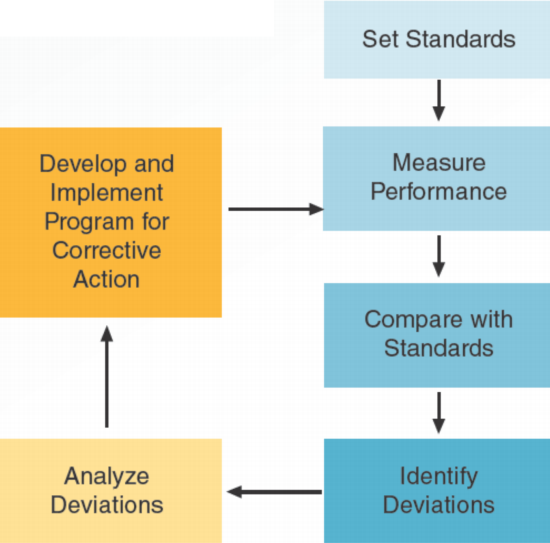
Control Mechanisms
| Type | Timing | Function | Example |
|---|---|---|---|
| Feedforward | Before input | Anticipates problems (preventive) | Equipment maintenance checks |
| Concurrent | During process | Corrects issues in real-time | Quality checks on assembly line |
| Feedback | After output | Corrects future performance using past data | Customer satisfaction surveys |
Methods to Maintain Control
| Method | Basis of Control | Key Characteristics |
|---|---|---|
| Bureaucratic | Rules, policies, hierarchy | Slow response, resistance to change |
| Objective | Measurable outputs/behaviors | Subtypes: Behavior vs. Output control |
| Normative | Shared values/beliefs | Hiring for cultural fit, storytelling |
| Concertive | Work group values | Autonomy-driven, peer pressure |
| Self-Control | Self-set goals & monitoring | Personal accountability |
Key Distinctions:
- Objective Control:
- Behavior control: Regulates actions (e.g., call center scripts)
- Output control: Regulates results (e.g., sales targets)
- Concertive vs. Normative:
- Concertive emerges from teams
- Normative from organizational culture.
Managerial Control Aspects
1. Balanced Scorecard
Measures performance across 4 perspectives:
- Financial (e.g., ROI, EVA)
- Customer (e.g., retention, satisfaction)
- Internal Operations (e.g., quality, efficiency)
- Innovation/Learning (e.g., employee skills, R&D)
Benefit: Prevents suboptimization (improving one area at another’s expense).
2. Financial Control Tools
-
Key Ratios:
Objective Ratio Meaning Liquidity Current Ratio Tests short-term solvency Leverage Debt-to-Assets Measures financial leverage Activity Inventory Turnover Efficiency of inventory use Profitability Return on Investment Asset profit efficiency -
Economic Value Added (EVA):
- $\text{EVA}=\text{Revenue}-\text{Cost}-\color{blue}\text{Capital Cost}$
Costcontains expenses, taxes, etc.- Cost of capital shows degree of which a project pay for itself
3. Customer Defection/Retention Control
- Track defection rate to retain profits and gain honest feedback. [判断员工是否计划离职以最小化损失]
4. Quality Control
| Quality Measure | Advantage(s) | Disadvantage(s) |
|---|---|---|
| Excellence | Motivational, appeals to customers | Ambiguous, hard to measure |
| Value | Customer-focused, measurable | Difficult to balance cost vs. quality |
| Conformance to Specification | Standardizes quality, efficient | Less adaptable, poor fit for services |
- Total Quality Management(TQM) [灵活变通], principles:
- Customer focus and satisfaction
- Continuous improvement
- Teamwork
5. Innovation & Learning
- Focus: Continuous improvement, sustainability (waste reduction → reuse → disposal).
Summary

Section 21. Managing Information, Service and Manufacturing Operations
Information Management
Moore’s Law
- Prediction that computer processing power doubles every ~2 years while costs halve
- Current challenge: Rising costs & need for improved density (e.g., TSMC’s approach)
Sustaining Competitive Advantage
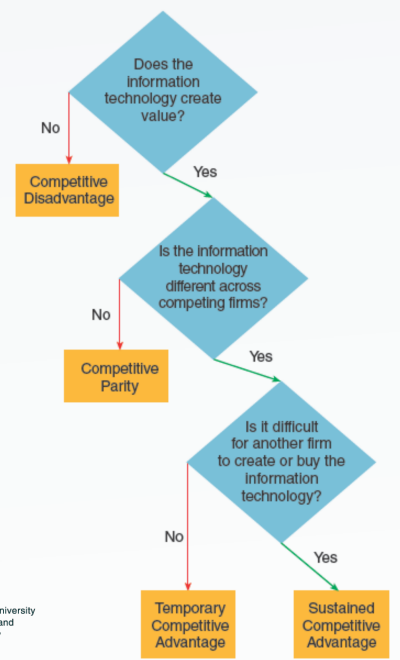
Internet’s Impact on Competitive Forces
| Force | Impact of Internet |
|---|---|
| Substitute Products | Enables new substitutes with innovative approaches |
| Customer Power | Global price transparency shifts power to customers |
| Supplier Power | Online procurement increases buyer power; reduces intermediaries |
| New Entrants | Lowers barriers (e.g., no need for physical sales force) |
| Industry Rivalry | Widens markets, increases competitors, pressures price competition |
Information Systems Hierarchy
| System Type | Users | Function |
|---|---|---|
| Executive (EIS) | Executives | Strategic decisions |
| Decision Support (DSS) | Senior Managers | Complex decision-making |
| Management (MIS) | Managers | Operational efficiency & control |
| Transaction Processing (TPS) | Workers | Basic reporting & data entry |
Service Business Management
Service-Profit Chain

Service Recovery
- Key elements:
- Empower employees to resolve issues immediately
- Exceed expectations of fair treatment
- Focus on restoring satisfaction for highly dissatisfied customers
Manufacturing Operations
Classification by Processing Amount
| Type | Description | Example |
|---|---|---|
| Make-to-Order (MTO) | Production starts ONLY after customer order | Custom vehicles |
| Assemble-to-Order (ATO) | Pre-made modules combined into semi-custom products | Dell computers |
| Make-to-Stock (MTS) | Standardized products assembled BEFORE orders | Smartphones, furnitures |
Classification by Flexibility
| Type | Flexibility | Characteristics | Example |
|---|---|---|---|
| Job Shops | Highest | Custom/small batches; unique setups | Handicraft |
| Batch Production | High | Large batches in standard sizes | Food industry |
| Line-Flow Production | Low | Serial processes; dedicated to one product | Automobile assembly |
| Continuous-Flow Production | Lowest | Produces goods at a continuous rate | Pharmaceutical factories |
Inventory Management
Inventory Types/Levels
- Raw Materials
- Component Parts
- Work-in-Process
- Finished Goods
Key Metrics
-
Average aggregate inventory: Average overall inventory during a particular time period
-
Weeks of supply: Time until stock depletion
-
Inventory turnover: Annual sales / average inventory
-
Stockout: When finished goods inventory = 0
Inventory Costs
| Cost Type | Description |
|---|---|
| Ordering | Paperwork, data entry for new orders |
| Setup | Machine adjustment costs for new product runs |
| Holding | Storage, insurance, obsolescence |
| Stockout | Lost sales + customer goodwill loss |
Management Techniques
| Technique | Principle | Formula/Application |
|---|---|---|
| EOQ (Economic order quantity) | Minimizes ordering + holding costs | $EOQ=\sqrt{2DO/H}$ |
| JIT (Just-in-time) | Near-zero inventory; parts arrive exactly when needed | Requires supplier proximity + shared IT systems |
| MRP (Materials requirement planning) | Production scheduling via: 1. Master schedule 2. Billing of materials 3. Inventory records |
For dependent demand systems |
- Explanation of EOQ:
- $D$: material usage (e.g. gallons of paint per year)
- $O$: ordering cost each
- $H$: holding costs (e.g. dollars per gallons)
Demand Systems
| Type | Description | Suitable Technique |
|---|---|---|
| Independent | Inventory levels unrelated | EOQ |
| Dependent | Inventory types tied to finished goods | JIT or MRP |